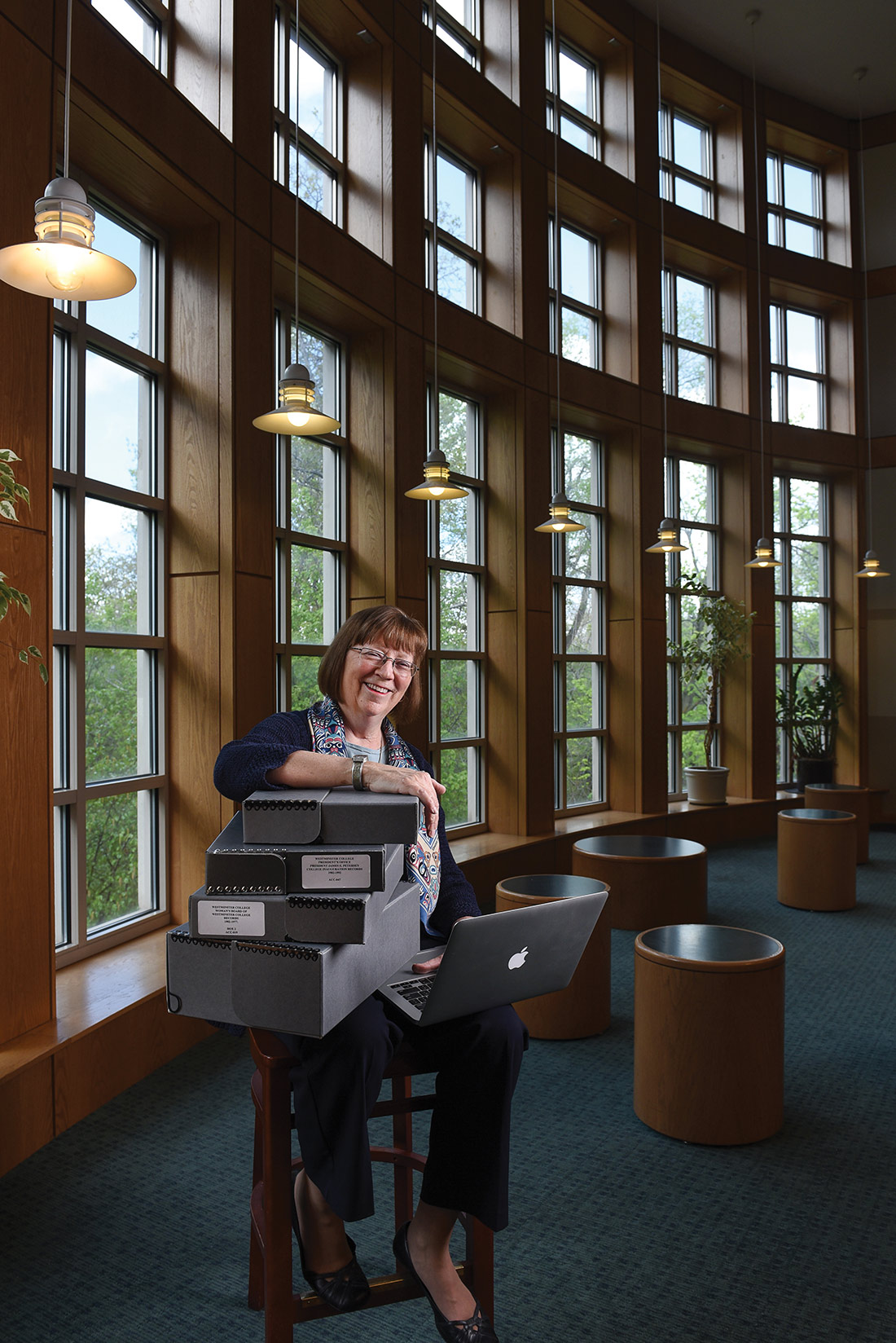
Let’s Get Digital
Sarah Shaw places Westminster’s archival collections on the digital map
by Autumn Thatcher (MSC ’15)
In a small room located on the second floor of the Giovale Library reside over 200 collections comprising thousands of documents in Westminster’s archives. The archives collection is not romantic in the way one would imagine after watching Hollywood films. There is no spiral staircase or big table holding ancient documents under a sheet of glass waiting to be inspected by a scholar. But there are documents—such as a 1904 handwritten letter to George Sweazey, the Salt Lake Collegiate Institute principal, offering the exchange of potatoes for tuition—that have become little treasures for some researchers.
“There was a PhD student who flew out here because of these encoded archival descriptions and used the contents of those collections for her dissertation work,” explains Christopher Dasanjh, head of collections and access.
The PhD candidate Christopher references—and other researchers since her—discovered Westminster’s archives through the help of an online finding aid, which is a guide to an archival collection. These aids are similar to a cataloging record but include a more detailed description and put the collection into context. Christopher explains that Westminster’s archival collection—a group of unique documents such as papers, correspondence, photos, scrapbooks, business records, and manuscripts—has only recently landed on the radar of scholars around the globe. Christopher points to Sarah Shaw as the person who put Westminster’s archival collection on the digital map.
A retired librarian, Sarah is the spouse of Westminster’s former dean of education Bob Shaw. Sarah was introduced to encoded archival description (EAD) in 2003, when her employer at Brown University requested that she learn how to get its special-collection library finding aids online. The university sent her to Rare Books School at the University of Virginia, where Daniel Pitti—the creator of EAD coding—was on staff. Sarah spent one week learning the ropes of EAD coding with 25 other librarians.
She returned to Brown University armed with the knowledge to create online finding aids for its archival collection. She went on to provide training in coding to employees from the special collections and catalog departments. Sarah says that her background in cataloging helped the transition to digital coding feel natural.
“Catalogers are poised to understand code,” she says. “You are used to something similar in the cataloging work.”
Sarah spent the next four years supervising inflow of finding aids that were ready to go up on the university’s website. In 2007, she left her position at Brown to accompany her husband in moving to Utah.
“I really love doing EAD, and the Utah Manuscripts Association was just releasing its best-practices guideline for doing EAD in the state,” Sarah says.
Sarah went to the University of Utah and volunteered to analyze finding aids on Mountain West Digital Library for compliance with local and national standards. Her expertise in the field led to consulting opportunities.
In 2007, Sarah met David Hales, former head librarian at Westminster College, for a tour of the college’s archives. She was drawn to a unique aspect of the archives: a rich history on Presbyterianism in Utah.
“I am the child of a Presbyterian minister; two of my uncles are Presbyterian ministers. I went to Occidental College and received a scholarship as the child of a Presbyterian minister,” Sarah explains. “It was interesting to me that this place held all these papers of early Presbyterianism.”
At the time, Westminster had been keeping record of its archival collection through Word documents. It was enough, Sarah says, to fit the minimum requirements for a finding aid.
“What they didn’t have was subject access that you get in a lot of finding aids. And they weren’t coded to be in a database and searchable,” Sarah says.
As she examined the Word documents, Sarah realized the timing was perfect: She had just finished her consulting jobs and wanted something to do. In 2010, Sarah volunteered to take the archival collection and create EAD finding aids for Westminster. Her passion for the craft resulted in seven years and over 2,100 hours donated to the Westminster library.
Christopher says that Sarah’s work was no easy feat.
“It takes an incredible amount of attention to detail and patience,” Christopher says. “Sarah has completed all the encoded archives’ selections and enabled us to communicate to researchers what we have in our archives. The work that she is doing is really high-quality work.”
Sarah completed the project in May of 2017. “I have gone a little overboard,” Sarah admits. “I linked related photos and collections, searched for birth certificates and obituaries: I have indulged myself in loading these finding aids up with added value to researchers.”
Christopher is excited for the opportunities that the completion of this project represents.
“Our collections are captured by the Mountain West Digital Library, an aggregator of archival collections in the Mountain West region. If researchers go to this one place, they can research anything that has been digitized,” Christopher explains. “It allows anyone who is interested in seeing the history of the college to see what we have upstairs in the archive.”
About the Westminster Review
The Westminster Review is Westminster University’s bi-annual alumni magazine that is distributed to alumni and community members. Each issue aims to keep alumni updated on campus current events and highlights the accomplishments of current students, professors, and Westminster alum.
GET THE REVIEW IN PRINT STAY IN TOUCH SUBMIT YOUR STORY IDEA READ MORE WESTMINSTER STORIES
